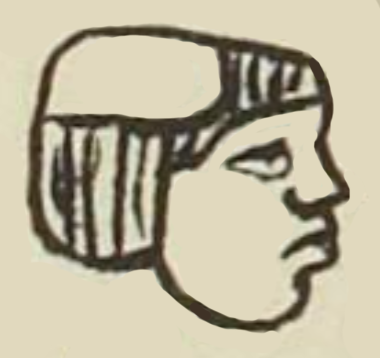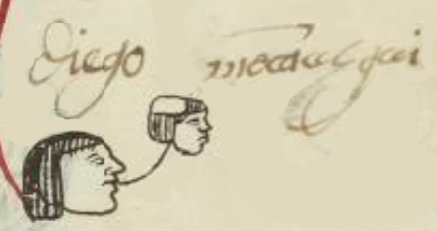Mecauhqui (MH815r)
This black-line drawing of the simplex glyph for the personal name Mecauhqui (perhaps “He Who Gets Rope” or “He With One or More Mistresses”) is attested here as a man’s name. The glyph shows the head of a man in profile, facing toward the viewer’s right. He has an oval-shaped hairless patch on the top of his head, toward the back.
Stephanie Wood
Glyphs like this are common for the name Tlapal, but see also Mexi and Huexotzincatl, below. The hairless patch appears to be an ethnic marker at least some of the time. Another, similar name is Mocauhqui (perhaps “One Who Was Left” or “One Who Was Abandoned”), but the Me- start to this name is fairly certain.
Stephanie Wood
1560
Jeff Haskett-Wood
pelo, cabello, calvo, pelón, cordones, sogas, amantes, nombres de hombres

meca(tl), rope or cord, https://nahuatl.wired-humanities.org/content/mecatl
-hua (singular possessive suffix), one who had, https://nahuatl.wired-humanities.org/content/hua
mecahua, a man with one or more mistresses, https://nahuatl.wired-humanities.org/content/mecahua
-qui, one who does this, https://nahuatl.wired-humanities.org/content/qui
posiblemente, Él Que Obtenga Sogas, o Él Que Tiene Amantes
Stephanie Wood
Matrícula de Huexotzinco, folio 815r, World Digital Library, https://www.loc.gov/resource/gdcwdl.wdl_15282/?sp=704&st=image.
This manuscript is hosted by the Library of Congress and the World Digital Library; used here with the Creative Commons, “Attribution-NonCommercial-ShareAlike 3.0 License” (CC-BY-NC-SAq 3.0).






